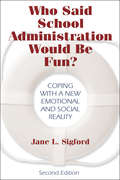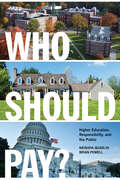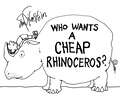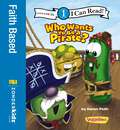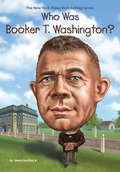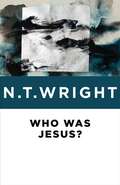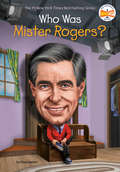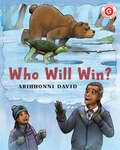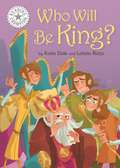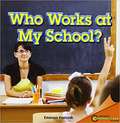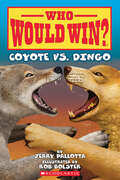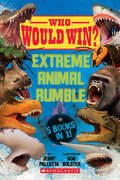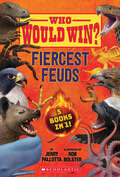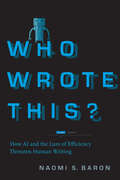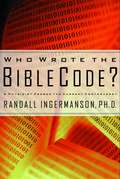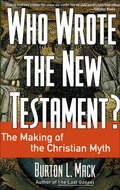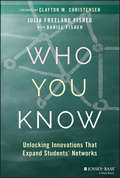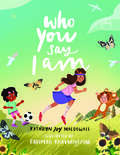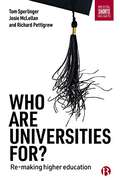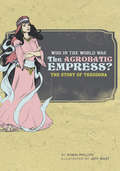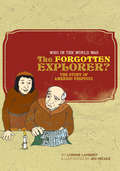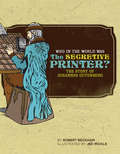- Table View
- List View
Who Said School Administration Would Be Fun?: Coping With a New Emotional and Social Reality
by Jane L. SigfordLearn the unwritten and unspoken rules of school administration in this second edition, which helps new and sitting administrators increase personal and professional fulfillment.
Who Shall Ascend the Mountain of the Lord?: A Biblical Theology of the Book of Leviticus (New Studies in Biblical Theology #Volume 37)
by L. Michael MoralesReformation 21's 2015 End of Year Review of BooksPreaching's
Who Should Pay? Higher Education, Responsibility, and the Public: Higher Education, Responsibility, and the Public
by Brian Powell Natasha QuadlinAmericans now obtain college degrees at a higher rate than at any time in recent decades in the hopes of improving their career prospects. At the same time, the rising costs of an undergraduate education have increased dramatically, forcing students and families to take out often unmanageable levels of student debt. The cumulative amount of student debt reached nearly $1.5 trillion in 2017, and calls for student loan forgiveness have gained momentum. Yet public policy to address college affordability has been mixed. While some policymakers support more public funding to broaden educational access, others oppose this expansion. Noting that public opinion often shapes public policy, sociologists Natasha Quadlin and Brian Powell examine public opinion on who should shoulder the increasing costs of higher education and why. Who Should Pay? draws on a decade’s worth of public opinion surveys analyzing public attitudes about whether parents, students, or the government should be primarily responsible for funding higher education. Quadlin and Powell find that between 2010 and 2019, public opinion has shifted dramatically in favor of more government funding. In 2010, Americans overwhelming believed that parents and students were responsible for the costs of higher education. Less than a decade later, the percentage of Americans who believed that federal or state/local government should be the primary financial contributor has more than doubled. The authors contend that the rapidity of this change may be due to the effects of the 2008 financial crisis and the growing awareness of the social and economic costs of high levels of student debt. Quadlin and Powell also find increased public endorsement of shared responsibility between individuals and the government in paying for higher education. The authors additionally examine attitudes on the accessibility of college for all, whether higher education at public universities should be free, and whether college is worth the costs. Quadlin and Powell also explore why Americans hold these beliefs. They identify individualistic and collectivist world views that shape public perspectives on the questions of funding, accessibility, and worthiness of college. Those with more individualistic orientations believed parents and students should pay for college, and that if students want to attend college, then they should work hard and find ways to achieve their goals. Those with collectivist orientations believed in a model of shared responsibility – one in which the government takes a greater level of responsibility for funding education while acknowledging the social and economic barriers to obtaining a college degree for many students. The authors find that these belief systems differ among socio-demographic groups and that bias – sometimes unconscious and sometimes deliberate – regarding race and class affects responses from both individualistic and collectivist-oriented participants. Public opinion is typically very slow to change. Yet Who Should Pay? provides an illuminating account of just how quickly public opinion has shifted regarding the responsibility of paying for a college education and its implications for future generations of students.
Who Wants a Cheap Rhinoceros?
by Shel SilversteinFrom New York Times bestselling author Shel Silverstein, acclaimed creator of Where the Sidewalk Ends, The Giving Tree, A Light in the Attic, and Falling Up, comes a boy’s tribute to a perfectly unexpected pet: a rhinoceros.In this cherished classic, published for the first time at HarperCollins, Silverstein delivers a hilarious look at the joys of having a rhinoceros as your friend, with his signature humor and black-and-white artwork.Generations have grown up with the works of Shel Silverstein, known not only as a poet and illustrator, but also for his work as a cartoonist, playwright, performer, recording artist, and Grammy Award-winning songwriter. With the timeless magic of his work, Shel Silverstein has encouraged children to dream and dare to imagine the impossible with his extraordinary poetry and unforgettable characters.Need a pet? What’s the best kind to get?A dog, a cat, a frog, a rat?How about a cheap rhinoceros?He’s funny and sweet and loyal as they come.He’s huggable and lovable.So who wants a cheap rhinoceros?Maybe you!
Who Wants to Be a Pirate?: Level 1 (I Can Read! / Big Idea Books / VeggieTales)
by Karen PothA Lesson about Self EsteemThe Pirates Who Don&’t Do Anything want to try something new. Will Larry, Lunt, and Pa Grape be happy when they try to be someone they&’re not?This is a Level One I Can Read! book, which means it&’s perfect for children learning to sound out words and sentences. It aligns with guided reading level I and will be of interest to children Pre-K to 2nd grade.
Who Was Booker T. Washington? (Who was?)
by James Buckley Who Hq Jake MurrayLearn how a slave became one of the leading influential African American intellectuals of the late 19th century.African American educator, author, speaker, and advisor to presidents of the United States, Booker Taliaferro Washington was the leading voice of former slaves and their descendants during the late 1800s. As part of the last generation of leaders born into slavery, Booker believed that blacks could better progress in society through education and entrepreneurship, rather than trying to directly challenge the Jim Crow segregation. After hearing the Emancipation Proclamation and realizing he was free, young Booker decided to make learning his life. He taught himself to read and write, pursued a formal education, and went on to found the Tuskegee Institute--a black school in Alabama--with the goal of building the community's economic strength and pride. The institute still exists and is home to famous alumnae like scientist George Washington Carver.
Who Was Jesus?: Rediscovering Who Jesus Was And Is (The\ivp Signature Collection)
by N. T. WrightDid the historical person Jesus really regard himself as the Son of God? What did Jesus actually stand for? And what are we to make of the early Christian conviction that Jesus physically rose from the dead?In this book N. T. Wright considers these and many other questions raised by three controversial books about Jesus: Barbara Thiering's Jesus the Man, A. N. Wilson's Jesus: A Life, and John Shelby Spong's Born of a Woman. While Wright agrees with those authors that the real, historical Jesus has many surprises in store for institutional Christianity, he also presents solid reasons for discounting their arguments, claiming that they "fail to reach anything like the right answer" as to who Jesus really was.Written from the standpoint of professional biblical scholarship yet assuming no prior knowledge of the subject, Wright's Who Was Jesus? shows convincingly that much can be gained from a rigorous historical assessment of what the Gospels say about Jesus. This is a book to engage skeptics and believers alike.
Who Was Mister Rogers? (Who Was?)
by Diane Bailey Who HQLearn how Fred Rogers, a minister and musician from Pennsylvania, became one of America's most beloved television personalities and everyone's favorite neighbor.Even though he's best known for his successful PBS series Mister Rogers' Neighborhood, Fred Rogers never dreamed of working in television. In fact, he hated the very first program that he ever watched! Join author Diane Bailey as she takes readers through the journey that brought Mister Rogers into our living rooms. From his childhood interest in puppet-making and music, to his courageous visit to Russia during the Cold War, this book details Mister Rogers's quest for kindness and his gentle appeal to be more neighborly.
Who Will Tell My Brother?
by Marlene CarvellInternational Reading Association Children's Book Award Winner. Determined to sway high school officials to remove disparaging Indian mascots, Evan assumes a struggle that spirals him onto a soul-searching journey and exposes him to a barrage of bullying, taunts, and escalating violence. Marlene Carvell's striking first novel is a timely look at a true story of a mixed-race teen caught up in an exploration of his past, his culture, and his identity.
Who Will Win? (I Like to Read)
by Arihhonni DavidBear has fast legs. Turtle has a fast mind. Who will win the race? A fun Native American tale that kindergarteners and first graders can read on their own.Ready, set, go! Bear will go over the ice. Turtle will go under the ice. Bear runs fast. But where is Turtle?When a quick-footed bear and a quick-witted turtle race across a frozen lake, Turtle has a secret plan to win! Written and illustrated by Mohawk author-illustrator Arihhonni David, this easy reader based on a Native American tale combines exciting storytelling and easy-to-read language. This book has been officially leveled by using the Fountas & Pinnell Text Level GradientTM leveling system. The award-winning I Like to Read® series focuses on guided reading levels A through G, based upon Fountas and Pinnell standards. Acclaimed author-illustrators--including winners of Caldecott, Theodor Seuss Geisel, and Coretta Scott King honors--create original, high-quality illustrations that support comprehension of simple text and are fun for kids to read again and again with their parents, teachers or on their own!
Who Will be King?: Independent Reading White 10 (Reading Champion #248)
by Katie DaleReading Champion offers independent reading books for children to practise and reinforce their developing reading skills.Fantastic, original stories are accompanied by engaging artwork and a reading activity. Each book has been carefully graded so that it can be matched to a child's reading ability, encouraging reading for pleasure.
Who Works at My School? (Infomax Common Core Readers)
by Emerson FronczakThe duties of the teacher, music teacher, art teacher, gym teacher, nurse, and cook are explained in a question and answer format.
Who Would Win?: Coyote vs. Dingo (Who Would Win?)
by Jerry PallottaWhat if a coyote and dingo had a fight? Who do you think would win?This nonfiction reader compares and contrasts two ferocious animals: a coyote and a dingo! Readers will learn about each animal's anatomy, behavior, and more. Then compare and contrast the battling pair before finally discovering the winner! This nonfiction series is full of facts, photos, and realistic illustrations, and it includes a range of mammals, sea creatures, insects, and dinosaurs to satisfy all kinds of animal fans.
Who Would Win?: Extreme Animal Rumble (Who Would Win?)
by Jerry PallottaEighty fierce animals battle it out in this exciting bind-up featuring five books in this action-packed animal series!Which dangerous animals would win in a fight? Find out in this awesome bind-up of five books in the popular Who Would Win? series! The collection features a range of mammals, sea creatures, reptiles, and dinosaurs to satisfy all kinds of animal fans, including Ultimate Bug Rumble, Ultimate Jungle Rumble, Ultimate Dinosaur Rumble, Ultimate Shark Rumble, and Ultimate Ocean Rumble.Kids will learn about each animal's anatomy, behavior, and more alongside photos, charts, illustrations, and amazing facts.
Who Would Win?: Fiercest Feuds (Who Would Win?)
by Jerry PallottaTen fierce animals battle it out in this exciting bind-up featuring five books in this action-packed animal series!Which dangerous animals would win in a fight? Find out in this awesome bind-up of five books in the popular Who Would Win? series. The collection features a range of mammals, sea creatures, reptiles, and birds to satisfy all kinds of animal fans, including Falcon vs. Hawk, Hyena vs. Honey Badger, Komodo Dragon vs. King Cobra, Tarantula vs. Scorpion, and Whale vs. Giant Squid.Kids will learn about each animal's anatomy, behavior, and more alongside photos, charts, illustrations, and amazing facts.
Who Wrote The Bible
by Richard Elliott Friedman"Richard Elliott Friedman focuses on the central books of the Old Testament--Genesis, Exodus, Leviticus, Numbers, and Deuteronomy--and makes a persuasive argument for the identities of their four different authors. Drawing upon the most recent archeological discoveries, Friedman presents a vivid picture of the world of the Bible as he examines where and when these writers lived, the politics and history embedded in their stories, and their relationship to the events they describe and to one another. Challenging many conventional theories of biblical scholarship, he also sheds light on the marvel of the Bible's synthesis, on how the various documents were brought together to form a single text. Who Wrote the Bible? enriches our understanding of the Bible as literature, as history, and as sacred text, and is indispensable for anyone who loves and reads the Good Book."
Who Wrote This?: How AI and the Lure of Efficiency Threaten Human Writing
by Naomi S. BaronWould you read this book if a computer wrote it? Would you even know? And why would it matter? Today's eerily impressive artificial intelligence writing tools present us with a crucial challenge: As writers, do we unthinkingly adopt AI's time-saving advantages or do we stop to weigh what we gain and lose when heeding its siren call? To understand how AI is redefining what it means to write and think, linguist and educator Naomi S. Baron leads us on a journey connecting the dots between human literacy and today's technology. From nineteenth-century lessons in composition, to mathematician Alan Turing's work creating a machine for deciphering war-time messages, to contemporary engines like ChatGPT, Baron gives readers a spirited overview of the emergence of both literacy and AI, and a glimpse of their possible future. As the technology becomes increasingly sophisticated and fluent, it's tempting to take the easy way out and let AI do the work for us. Baron cautions that such efficiency isn't always in our interest. As AI plies us with suggestions or full-blown text, we risk losing not just our technical skills but the power of writing as a springboard for personal reflection and unique expression. Funny, informed, and conversational, Who Wrote This? urges us as individuals and as communities to make conscious choices about the extent to which we collaborate with AI. The technology is here to stay. Baron shows us how to work with AI and how to spot where it risks diminishing the valuable cognitive and social benefits of being literate.
Who Wrote the Bible Code?: A Physicist Probes the Current Controversy
by Randall IngermansonWhat is the truth about the Bible code? How can you decide what to believe? Why does it matter? Around the world, men and women are captivated by a theory so incredible that, if proven true, it would forever revolutionize mankind's view of Scripture. Some experts have claimed the Bible contains a code that accurately predicts today's events. Others renounce the Bible code theory as unfounded.Using a new statistical test that promises to provide an authoritative, credible answer to the Bible code debate, computational physicist Dr. Randall Ingermanson leads you on an easily understandable, meticulously planned investigation of the evidence at hand-addressing the most urgent questions surrounding the Bible code controversy and carefully examining how recent findings could affect your faith.From the Trade Paperback edition.
Who Wrote the New Testament?: The Making of the Christian Myth
by Burton L. Mack“One of those rare volumes that . . . makes one wonder how we could possibly have lived without it. . . . [A] must-read for any student of the New Testament.” —Publishers WeeklyIn this groundbreaking and controversial book, Burton Mack brilliantly exposes how the Gospels are fictional mythologies created by different communities for various purposes and are only distantly related to the actual historical Jesus.Mack‘s innovative scholarship which boldly challenges traditional Christian understanding will change the way you approach the New Testament and think about how Christianity arose.“A powerful, compact, yet detailed introduction to the New Testament and the origins of Christianity. Mack has sketched the panorama of early Christian literature and social development in a lucid, convincing, and magisterial performance.”— Robert W. Funk, founder of the Jesus Seminar and author of The Five Gospels“Certainly Mack's book should take a place in the front ranks [of New Testament introductions].” —Booklist “Finally! Someone has penetrated the theological agenda that has informed a century of New Testament scholarship to provide a thoroughgoing historical overview of Christian origins.” Luther H. Martin, author of Hellenistic Religions
Who You Know: Unlocking Innovations That Expand Students' Networks
by Julia Freeland FisherImprove student outcomes with a new approach to relationships and networks Relationships matter. Who You Know explores this simple idea to give teachers and school administrators a fresh perspective on how to break the pattern of inequality in American classrooms. It reveals how schools can invest in the power of relationships to increase social mobility for their students. Discussions about inequality often focus on achievement gaps. But opportunity is about more than just test scores. Opportunity gaps are a function of not just what students know, but who they know. This book explores the central role that relationships play in young people’s lives, and provides guidance for a path forward. Schools can: Integrate student support models that increase access to caring adults in students’ lives Invest in learning models that strengthen teacher-student relationships Deploy emerging technologies that expand students’ networks to experts and mentors from around world Exploring the latest tools, data, and real-world examples, this book provides evidence-based guidance for educators looking to level the playing field and expert analysis on how policymakers and entrepreneurs can help. Networks need no longer be limited by geography or circumstance. By making room for relationships, K-12 schools can transform themselves into hubs of next-generation learning and connecting. Who You Know explains how.
Who You Say I Am
by Kathryn Joy MacDowallInspired by the Hillsong Worship song &“Who You Say I Am,&” this beautiful picture book honors each child&’s unique qualities while reminding us that our identity in God is always the most important part of who we are. &“I am who You say I am!&” we can shout. I know who I am without a doubt. God made each one of us with different personalities, fun preferences, and unique gifts. But the thing that is most important about us is always the same: His love for us! In Who You Say I Am, vibrant illustrations take readers ages 3-8 from school to the zoo, from ballet class to the beach, as hand-lettered rhymes and Bible verses explore the truth that we are chosen, forgiven, and God&’s beloved workmanship.
Who are Universities For?: Re-making Higher Education
by Tom Sperlinger Josie McLellanThe university system is no longer fit for purpose. UK higher education was designed for much smaller numbers of students and a very different labour market. Students display worrying levels of mental health issues, exacerbated by unprecedented levels of debt, and the dubious privilege of competing for poorly-paid graduate internships. Meanwhile who goes to university is still too often determined by place of birth, gender, class or ethnicity. Who are universities for? argues for a large-scale shake up of how we organise higher education, how we combine it with work, and how it fits into our lives. It includes radical proposals for reform of the curriculum and how we admit students to higher education, with part-time study (currently in crisis in England) becoming the norm. A short, polemical but also deeply practical book, Who are universities for? offers concrete solutions to the problems facing UK higher education and a way forward for universities to become more inclusive and more responsive to local and global challenges.
Who in the World Was The Acrobatic Empress?: The Story of Theodora (Who in the World)
by Jeff West Robin PhillipsDiscover the intriguing story of Empress Theodora in this junior-level biography from Peace Hill Press. The Emperor Justinian could not decide what to do. His people were rioting. An angry mob poured through the streets, looting, setting fires, and destroying houses and taverns. If they reached the palace, they might kill him. Justinian's trusted advisers pressed him to run to the port and sail away, giving up his throne to save his life. He turned and looked at his wife, the wisest person in the room. What would she, the Empress Theodora, urge him to do? Outstanding illustrations from Jeff West complement the fabulous story, giving second-grade readers insight into the life of this 6th century ruler. About the series: The classical curriculum introduces even the youngest student to the pleasures of true learning. Elementary students learn history not through predigested textbooks with multiple-choice answers, but through reading the stories of history. Unfortunately, biographies of great men and women of the past are almost all written for older students, limiting the ability of young students to explore history through reading. Libraries are crammed with biographies written for high school students and adults--while beginning readers are provided with a shelf full of junior-level books about football players, NASCAR drivers, and movie stars. Now, Peace Hill Press puts real history back into the grasp of the youngest historians with the Who in the World Biography Series. The first entries in the series provide young readers and their parents and teachers with biographies of great men and women of the Middle Ages. Designed to be used as part of The Story of the World curriculum, these biographies give beginning historians in grades 2-4 a chance to explore beyond the textbook. An audio version is also available separately.
Who in the World Was The Forgotten Explorer?: The Story of Amerigo Vespucci (Who in the World)
by Jed Mickle Lorene LambertDiscover the intriguing story of Amerigo Vespucci in this junior-level biography from Peace Hill Press. When Columbus landed on the islands in the Caribbean Sea, he thought he was off the coast of China. A few years later, Amerigo Vespucci sailed west, hoping to find a new route to the East. Instead, he discovered new lands that nobody at home knew about. What did he see? Who did he tell? And why is America named after him? Outstanding illustrations from Jed Mickle complement the fabulous story, giving second-grade readers insight into the life of this discoverer. About the series: The classical curriculum introduces even the youngest student to the pleasures of true learning. Elementary students learn history not through predigested textbooks with multiple-choice answers, but through reading the stories of history. Unfortunately, biographies of great men and women of the past are almost all written for older students, limiting the ability of young students to explore history through reading. Libraries are crammed with biographies written for high school students and adults--while beginning readers are provided with a shelf full of junior-level books about football players, NASCAR drivers, and movie stars. Now, Peace Hill Press puts real history back into the grasp of the youngest historians with the Who in the World Biography Series. The first entries in the series provide young readers and their parents and teachers with biographies of great men and women of the Middle Ages. Designed to be used as part of The Story of the World curriculum, these biographies give beginning historians in grades 2-4 a chance to explore beyond the textbook. An audio version is also available separately.
Who in the World Was The Secretive Printer?: The Story of Johannes Gutenberg (Who in the World)
by Jed Mickle Robert BeckhamDiscover the intriguing story of Johannes Gutenberg in this junior-level biography from Peace Hill Press. Johannes Gutenberg spent his days shut away, working on a mysterious project. His neighbors wondered what he was doing in his metal shop. Why did he need so much money? Was he making expensive gold jewelry? Weapons? Armor? What project could possibly take up so many hours of Johannes's time? And how did his invention change the world? Outstanding illustrations from Jed Mickle complement the fabulous story, giving second-grade readers insight into the life of this influential figure. About the series: The classical curriculum introduces even the youngest student to the pleasures of true learning. Elementary students learn history not through predigested textbooks with multiple-choice answers, but through reading the stories of history. Unfortunately, biographies of great men and women of the past are almost all written for older students, limiting the ability of young students to explore history through reading. Libraries are crammed with biographies written for high school students and adults--while beginning readers are provided with a shelf full of junior-level books about football players, NASCAR drivers, and movie stars. Now, Peace Hill Press puts real history back into the grasp of the youngest historians with the Who in the World Biography Series. The first entries in the series provide young readers and their parents and teachers with biographies of great men and women of the Middle Ages. Designed to be used as part of The Story of the World curriculum, these biographies give beginning historians in grades 2-4 a chance to explore beyond the textbook. An audio version is also available separately.
